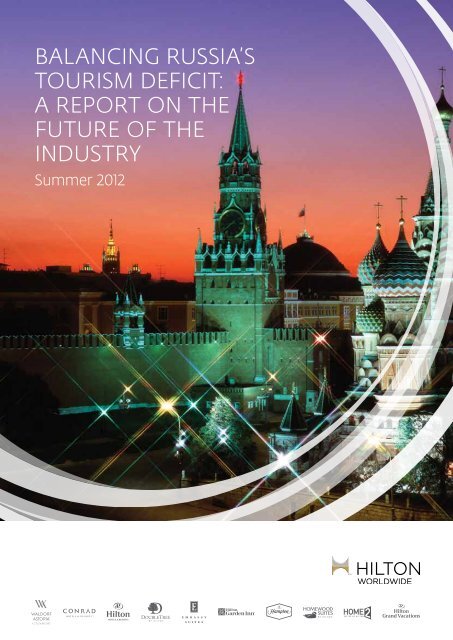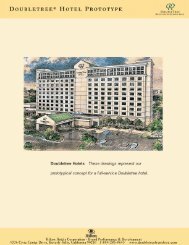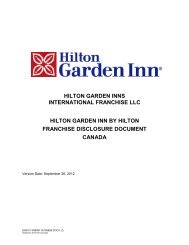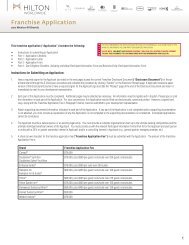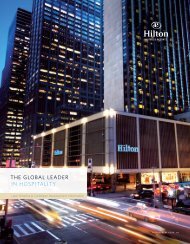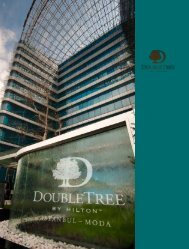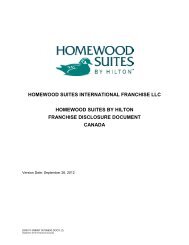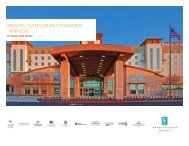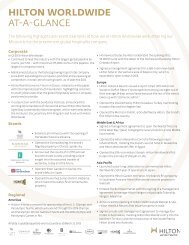Balancing Russia's touRism deficit: a RepoRt on ... - Hilton Worldwide
Balancing Russia's touRism deficit: a RepoRt on ... - Hilton Worldwide
Balancing Russia's touRism deficit: a RepoRt on ... - Hilton Worldwide
Create successful ePaper yourself
Turn your PDF publications into a flip-book with our unique Google optimized e-Paper software.
<str<strong>on</strong>g>Balancing</str<strong>on</strong>g> Russia’stourism <str<strong>on</strong>g>deficit</str<strong>on</strong>g>:A report <strong>on</strong> thefuture of theindustrySummer 2012
2Hilt<strong>on</strong> Moscow Leningradskaya
3ForewordTourism in Russia has grown rapidly. Fuelled by the country’sstr<strong>on</strong>g ec<strong>on</strong>omy, rich history and vast geography, bothoutbound and inbound tourism have flourished. Russia has<strong>on</strong>e of the biggest outbound travel markets in the world,registering over 40 milli<strong>on</strong> outbound tourists last year, withgrowth predicted to c<strong>on</strong>tinue. Inbound tourism has alsobeen <strong>on</strong> the rise with over 22 milli<strong>on</strong> internati<strong>on</strong>al touristarrivals in 2011, an increase of 11% <strong>on</strong> the previous year. Russiais therefore an important market and has been identifiedas a key growth area by Hilt<strong>on</strong> <strong>Worldwide</strong>, with more hotelopenings planned in Russia over the next few years thananywhere else in Europe.But while there is steady growth in travellers to and fromRussia, those visiting the country spent US$9.9 billi<strong>on</strong> in2011, compared to Russian outbound travellers who spentUS$32.4 billi<strong>on</strong>, more than triple that of inbound travellers.Government investment in tourism development and majorsporting events such as the Winter Olympics and the WorldCup will of course attract many more visitors to Russia, butthe discrepancy between outbound and inbound expendituresuggests more can be d<strong>on</strong>e for travellers visiting the country.In doing so, Russia could derive greater benefit from tourismand the positive impact it can have <strong>on</strong> job creati<strong>on</strong>, GrossDomestic Product (GDP) and capital investment.In order to better understand this important opportunityin the c<strong>on</strong>text of Russia‘s wider tourism industry, wecommissi<strong>on</strong>ed Eurom<strong>on</strong>itor Internati<strong>on</strong>al, world leadersin strategy research, to explore recent and future trends ininbound, outbound and domestic tourism in Russia. Theresult is ‘<str<strong>on</strong>g>Balancing</str<strong>on</strong>g> Russia’s tourism <str<strong>on</strong>g>deficit</str<strong>on</strong>g>: A report <strong>on</strong> thefuture of the industry’ which makes a timely and significantc<strong>on</strong>tributi<strong>on</strong> to understanding the l<strong>on</strong>g term potential oftourism in Russia, what challenges the industry faces, and themeasures that need to be undertaken to make the country’stourism business more competitive.Hilt<strong>on</strong> <strong>Worldwide</strong> is committed to playing an active role insupporting Russian tourism over the l<strong>on</strong>g term. Across thecountry we plan to open 28 hotels over the next few years,with brands including Hilt<strong>on</strong> Hotels & Resorts, DoubleTreeby Hilt<strong>on</strong>, Hilt<strong>on</strong> Garden Inn andHampt<strong>on</strong> by Hilt<strong>on</strong>. Ourgrowing presence will also help create over 3,000 jobopportunities.Working closely with the travel and tourism industry, andgovernment organisati<strong>on</strong>s, we will c<strong>on</strong>tinue to drive Russia’stourism agenda forward.We hope you find this report informative and engaging.Sim<strong>on</strong> VincentArea President, Europe, Hilt<strong>on</strong> <strong>Worldwide</strong>Hilt<strong>on</strong> Garden Inn Perm
4About this reportThis report was commissi<strong>on</strong>ed <strong>on</strong> behalf of Hilt<strong>on</strong><strong>Worldwide</strong> by Eurom<strong>on</strong>itor Internati<strong>on</strong>al - anindependent organisati<strong>on</strong> and a world leader instrategy research for c<strong>on</strong>sumer markets.In this report, Eurom<strong>on</strong>itor Internati<strong>on</strong>al providesan in-depth analysis of Russian tourism in order toprovide c<strong>on</strong>text to the penetrati<strong>on</strong> and prevalence ofoutbound, inbound and domestic tourism.Through a combinati<strong>on</strong> of primary and sec<strong>on</strong>daryresearch, the report investigates and addressesquesti<strong>on</strong>s about Russian travellers such as: the numberof Russian inbound, outbound and domestic travellers;main geographical areas of interest; growth driversand barriers c<strong>on</strong>straining inbound tourism; tourismexpenditure; and traveller groups. The report alsoanalyses tourism trends am<strong>on</strong>gst the BRIC nati<strong>on</strong>s(Brazil, Russia, India and China).Experts have given their opini<strong>on</strong>s and perspectives<strong>on</strong> key trends, developments, drivers and areas ofpotential focus.Hilt<strong>on</strong> Moscow Leningradskaya
5table of c<strong>on</strong>tentsExecutive Summary 6 – 11Industry Overview 12 – 13Inbound Tourism 14 – 18BRIC Analysis 19 – 20Outbound Tourism 21 – 26Domestic Tourism 27Tourism Expenditure 28 – 30Traveller Segments 31 – 33Methodology and References 34Hilt<strong>on</strong> Dalaman Resort & Spa
6executive summaryInbound tourism is in its early stagesIn 2011, the total number ofoutbound tourists reached40.8 milli<strong>on</strong>, increasing by11% in 2010 and indicatingan overall trend towardsgrowing outbound travel.Over 2011-2016, outboundtourism is expected to growby 7%. Russian outboundtourists spent US$32.4billi<strong>on</strong> <strong>on</strong> their travels in2011, up 21% <strong>on</strong> the previousyear. Outgoing touristexpenditure is expectedto grow by 8% over theforecast period (2011-2016).The total number of inbound tourists reached 22.4 milli<strong>on</strong> in 2011, with anincrease by 11% in 2010. It is expected to show a growth rate of 5% over 2011-2016.In 2011, inbound tourists spent US$9.9 billi<strong>on</strong>, up 9% <strong>on</strong> the previous year with anexpected increase of 2% over 2011-2016.While there is steady growth in travellers to Russia and growth in travellerspending in Russia (US$9.9 billi<strong>on</strong> in 2011), Russian outbound travellers spentUS$32.4 billi<strong>on</strong> – more than triple that of inbound travellers. This indicated morecan be d<strong>on</strong>e to cater the inbound market and that Russian inbound tourism is inits early stages.In 2011, the total number of domestic tourists reached 96.4 milli<strong>on</strong>, an increaseof 2.5% <strong>on</strong> 2010 and a predicted growth of 4.3% over 2011-2016 due to increasesin disposable income. Domestic tourists spent <strong>on</strong>ly US$21.1 billi<strong>on</strong> in 2011 anddomestic tourist expenditure is to see a moderate 4% increase to 2016.Russian outbound tourists mainly seek beaches and the sea, opting for Turkey,Egypt and Thailand as well as historical attracti<strong>on</strong>s in European cities in Italy,Spain and France. Shopping tourism is popular and c<strong>on</strong>venient in Finlandresulting in 3.8 milli<strong>on</strong> of outbound tourists in 2011. China is the third largestcountry for outbound tourism due to business trips to the country. In 2011, Russiawelcomed 6.6 milli<strong>on</strong> tourists from Ukraine, 2.6 milli<strong>on</strong> from Kazakhstan, 1.1milli<strong>on</strong> from each Uzbekistan and Finland.Hilt<strong>on</strong> BeijingC<strong>on</strong>rad IstanbulRome Cavalieri, Waldorf Astoria Hotels & Resorts
7executive summaryRussians spending more<strong>on</strong> leisure & tourismMid-income groups are starting to redefinepriorities in lifeInstead of focusing <strong>on</strong> advancing in their careers, forsaking holidaysand forgetting about recreati<strong>on</strong>, mid-income groups are seekinga more balanced life-work combinati<strong>on</strong> and thus spending moretime <strong>on</strong> leisure and tourism. This is especially true of mid-incomec<strong>on</strong>sumers in large cities.Beach vacati<strong>on</strong>s most popular in RussiaThe primary choice for Russian tourists is a beach vacati<strong>on</strong> in Turkey,Egypt, Greece, the United Arab Emirates or Thailand. The sec<strong>on</strong>dmost popular destinati<strong>on</strong> is Europe, with the leading countriesincluding Spain, Italy and France due to these countries offeringhistorical attracti<strong>on</strong>s, food and wine and shopping, combined withbeach holidays.Internet retailing is <strong>on</strong> the increaseGrowing internet household penetrati<strong>on</strong>, as well as tourists seekingcheaper prices, boosted internet retailing. Sales reached US$4.9billi<strong>on</strong> in 2011, of which 45% stemmed from airfare bookings, 25%from hotel bookings, 14% from railroad tickets and 16% from packagetours.RUSSIA’S LARGEST CITIES ARE THE MAINTOURIST ATTRACTIONMoscow and St Petersburg are the main destinati<strong>on</strong>s attractingtourists, offering historic buildings, theatres and museums. In 2011,historic buildings held a 22% share of tourist attracti<strong>on</strong> sales, whiletheatres accounted for 19% and museums for 17% share.
8executive summaryGovernment initiativesto stimulate tourismThe government is investing in developing tourisminfrastructure in order to improve the country’s ec<strong>on</strong>omicsituati<strong>on</strong>. The new federal tourism developmentprogramme was agreed by the Russian Parliament and isexpected to be <strong>on</strong>e of the main industry drivers over theforecast period. The programme’s US$11 billi<strong>on</strong> budget willbe invested in infrastructure and promoti<strong>on</strong>al activitiesuntil 2018. Moscow also plans to spend US$2 milli<strong>on</strong> <strong>on</strong>a city advertising campaign via Facebook, Twitter andRussia’s largest local social network, Vk<strong>on</strong>takte, by the endof 2012.The simplificati<strong>on</strong> of Russia’s visa system will also c<strong>on</strong>tributeto the growth of tourism in Russia. Although negotiati<strong>on</strong>saround the removal of visa requirements are still <strong>on</strong>going,some restricti<strong>on</strong>s have already been lowered. For example,all foreign visitors can now stay three days without a visa inSt Petersburg if arriving by ferry or cruise ship.Tourism growth in Russia is also expected to be boosted byupcoming events. In 2014 the Winter Olympic Games willbe hosted by Russia in Sochi. This destinati<strong>on</strong> is already apopular summer resort but after the Winter Olympic Gameswill become an attractive place for holidays or businessmeetings throughout the year. A modern transportati<strong>on</strong>system will be created, al<strong>on</strong>g with the c<strong>on</strong>structi<strong>on</strong> ofnew hotels and attracti<strong>on</strong>s for active summer and winterholidays, while old sanatoriums will be remodelled into spahotels. The FIFA Football World Cup in 2018 is also due to behosted in Russia, which will help to improve the country’simage and to attract new foreign visitors.Russia c<strong>on</strong>tinues to prosper <strong>on</strong> the back of commodities,with incomes and c<strong>on</strong>sumer demand rising str<strong>on</strong>gly asa result. This led to growing and more sophisticatedc<strong>on</strong>sumer demand for vacati<strong>on</strong>s while also encouragingc<strong>on</strong>sumers to travel more during holidays.Hilt<strong>on</strong> Sanya Resort and Spa
9executive summaryChallenges for Russian tourismVisa regimesAlthough the Russian authorities are focusing <strong>on</strong> visaregime simplificati<strong>on</strong>, travellers still encounter difficultiesin obtaining a visa when travelling to or from Russia. Theease of obtaining a visa varies significantly depending <strong>on</strong>the other country. In 2011, Belgium led visa refusals with 13%of applicati<strong>on</strong>s being rejected. However, the main problemwith existing visa regimes is not a high refusal rate butinstead the l<strong>on</strong>g period of time needed to obtain a visa aswell as the high price of it.Perceived security c<strong>on</strong>cernsTerrorism is another crucial factor impeding inboundtourism in Russia. Southern regi<strong>on</strong>s, including the ChechenRepublic, North Ossetia and Karachay-Cherkessia, haverich tourism potential. However, these are still am<strong>on</strong>gthe most dangerous territories in the world and are notrecommended for visits by either domestic or internati<strong>on</strong>altourists. In recent years, some terrorism attacks have alsotaken place in Moscow.Cash remains the most popularpayment methodDifficulties with Russia’s payment systems also c<strong>on</strong>straintourism growth. Cash is the most popular method ofpayment in the country. Merchant acceptance of majorfinancial card operators VISA and MasterCard is close to50%, while in developed card payment system countries thisratio is close to 100%.Travel transportati<strong>on</strong> andaccommodati<strong>on</strong> infrastructureDomestic tourism in Russia suffers from the poordevelopment of the country’s tourism infrastructure,including a shortage of accommodati<strong>on</strong> and entertainmentresources and the poor state of local attracti<strong>on</strong>s and roadnetwork. The infrastructure is also poorly adapted forpeople with disabilities as well as for foreign tourists due toa lack of supporting informati<strong>on</strong> in English. Accommodati<strong>on</strong>in Moscow is am<strong>on</strong>g the most expensive in the world, whichalso negatively influences domestic tourism. Moreover, thequality levels of accommodati<strong>on</strong> are very inc<strong>on</strong>sistent.Lack of tourist imageRussia lacks a c<strong>on</strong>sistently attractive image as a traveldestinati<strong>on</strong>, as it has not built a tourism brand forinternati<strong>on</strong>al tourists. Russia has invested little in creatingan attractive image for itself in comparis<strong>on</strong> to many othercountries.Problems with travel agenciesThis erodes the trust of travellers. As a result, some touriststravel independently while others stick to <strong>on</strong>e trustedoperator that they have had experience with, therebylimiting their tour choices.
10executive summaryOpportunities for growthGrowing <strong>on</strong>line retailOnline sales in travel and tourism are dem<strong>on</strong>strating rapidgrowth in Russia. Tourists increasingly use the internetto search for inexpensive opti<strong>on</strong>s of package holidaysand flights. As a result, a growing number of companiesare offering <strong>on</strong>line booking in their range of services.Furthermore, <strong>on</strong>line sales are being boosted by the risinghousehold penetrati<strong>on</strong> of internet enabled computers andchanging business models. As air companies increasinglycancelled service fees, travel retailers sought to boostother areas of income. As a result, Russian <strong>on</strong>line sales fortravel services in 2011 reached US$4.9 billi<strong>on</strong>. The furtherdevelopment of <strong>on</strong>line booking systems should increasethe number of independent tourists. Mobile applicati<strong>on</strong>sand social media is under development stage in Russia andstill lacks improvements. Only some Russian companiesuse this channel as an opportunity for business purposes,however Russians are getting more familiar with it,although in small stages.Development of event tourismThe advantages of event tourism include all-seas<strong>on</strong>interest and high profitability. Russia will be the hostcountry for global events such as the Winter OlympicGames in Sochi in 2014, 2018 FIFA World Cup and APECSummit in 2012. It is important to attract tourists not<strong>on</strong>ly during these events but also to make Russia moreappealing during these events, thus potentially attractingmany milli<strong>on</strong>s of internati<strong>on</strong>al tourists after the eventshave ended. Event tourism in Russia requires seriousdevelopment, however, as many previous events did notbecome ec<strong>on</strong>omically profitable due to a lack of promoti<strong>on</strong>and advertising.low-cost air carriersLow-cost carriers would increase the number of travellersin Russia within all c<strong>on</strong>sumer groups. The current presenceof low-cost air carriers is very low due to high airporttaxes, tight competiti<strong>on</strong> with Russian airlines and l<strong>on</strong>gdistances between Russian cities which influence theoverall cost of the flight.Investment in travel transportati<strong>on</strong>and accommodati<strong>on</strong>From 2011 <strong>on</strong>wards, the Russian authorities started toimplement a special programme: Available Envir<strong>on</strong>mentfor the Disabled. This resulted in changes in variousareas, including city infrastructure, tourist attracti<strong>on</strong>s,transportati<strong>on</strong> and others.The South of Russia meanwhile has a five year investmentplan focused <strong>on</strong> development in the southern regi<strong>on</strong>s ofthe country, including renovati<strong>on</strong> of the road and tourisminfrastructure.Small-scale unc<strong>on</strong>venti<strong>on</strong>al tourismThere are opportunities to develop regi<strong>on</strong>al small-scaleunc<strong>on</strong>venti<strong>on</strong>al tourism, such as event-based, ethnic,ecological and extreme tourism building <strong>on</strong> the Russianregi<strong>on</strong>s’ unique natural sites and historical heritage. TheKarelia and Baikal regi<strong>on</strong>s could for example attractoutdoor lovers of hunting, fishing, kayaking and raftingam<strong>on</strong>g other activities.L<strong>on</strong>d<strong>on</strong> Hilt<strong>on</strong> <strong>on</strong> Park Lane
11executive summaryRecommendati<strong>on</strong>sInternet as the main sourceThe internet will become the main source of informati<strong>on</strong> forpotential tourists. It is therefore important to increase the<strong>on</strong>line presence and <strong>on</strong>line promoti<strong>on</strong> of tourism offers availablein Russia.Event tourismAs Russia will be the host country for global events such as theWinter Olympic Games in Sochi in 2014 and the 2018 FIFA WorldCup, it is important to focus <strong>on</strong> infrastructure development for bothtransport and accommodati<strong>on</strong> in the cities where these events willtake place.China-Russia Tourism Year 2012With the tourist flow from China growing rapidly, it is importantto establish a greater physical and digital presence in China.Informati<strong>on</strong> about Russia should be made easily available in Chineseto potential tourists in China, while improving the informati<strong>on</strong> <strong>on</strong>China available to Russians in their own language.Development of affordable accommodati<strong>on</strong>Russia is <strong>on</strong>e of the most expensive countries in terms ofaccommodati<strong>on</strong>, which c<strong>on</strong>strains inbound as well as domestictourist flow in Russia. As a result, it is crucial to developaffordable and user-friendly accommodati<strong>on</strong> for low- and midincometourists.Development of new productsIn order to improve the experience for travellers, the developmentof new products such as tours, tour packages and organised visitsto places of interest is crucial. Tourists prefer pre-set services andpackages and want to travel smoothly, see a large number of placesand enjoy good quality service.Infrastructure developmentInfrastructure development is needed to improve tourists’experience, including roads, airports, intercity links, road and citysigns, shuttle buses and historical attracti<strong>on</strong>s. This includes makinginformati<strong>on</strong> available and understandable for foreign travellers.Regi<strong>on</strong>al administrati<strong>on</strong>’s roleA str<strong>on</strong>g enthusiasm for tourism development <strong>on</strong> a regi<strong>on</strong>al basisis important to ensure the future development of tourism in Russia.No federal programme will be successful unless the local authoritiesalso see tourism development as their goal.
12Industry OverviewIncreasing c<strong>on</strong>sumerexpenditureC<strong>on</strong>sumer income and expenditure perhousehold in Russia, 2007-2016 (US$ ‘000)US$ ‘000 per household$40$35$30$25$20$15$10$5$012.5$11.8 $10.12007$0.6$21.3$34.6$29.99.5 9.3$19.0$1.020122016$1.61412108642$0Saving ratio %Annual disposable income per householdC<strong>on</strong>sumer expenditure per household <strong>on</strong> leisure and recreati<strong>on</strong>C<strong>on</strong>sumer expenditure per householdAnnual savings ratioAlthough the Russian ec<strong>on</strong>omy was affected by the globalec<strong>on</strong>omic crisis over 2008-2009, annual disposable incomeper household grew by 13%, with c<strong>on</strong>sumer expenditurealso rising by 13% over 2007-2012. In Russia, the estimatedaverage income per household in 2012 was US$21,300,which is very low compared to countries such as Germany(US$61,200) and the UK (US$55,600). On the other hand,Russia has <strong>on</strong>e of the world’s highest number of billi<strong>on</strong>aires.Therefore, the growth of c<strong>on</strong>sumer expenditure was highlyrelated to increased expenditure by these super-wealthyhouseholds.C<strong>on</strong>sumer expenditure <strong>on</strong> leisure and recreati<strong>on</strong> is expectedto account for 5% of total c<strong>on</strong>sumer expenditure perhousehold in 2012. Expenditure <strong>on</strong> leisure and recreati<strong>on</strong>is mostly driven by increased expenditure <strong>on</strong> packagedholidays, which grew by 16% over 2007-2012. Due toincreased disposable income levels, Russians became morewilling to spend <strong>on</strong> vacati<strong>on</strong>s and tourism.Increased foreign investments, domestic c<strong>on</strong>sumpti<strong>on</strong>and political stability in Russia significantly influencedc<strong>on</strong>sumer expenditure and annual disposable income afterthe ec<strong>on</strong>omic downturn. As the Russian ec<strong>on</strong>omy recovers,annual disposable income per capita is expected to witnessan increase of 11% and c<strong>on</strong>sumer expenditure to c<strong>on</strong>tinuerising by 12% over 2012-2016. These trends, al<strong>on</strong>gsideincreasing globalisati<strong>on</strong> and growing opportunities to travelabroad, will have an impact <strong>on</strong> the tourism industry. Theywill also support a 12% growth in c<strong>on</strong>sumer expenditure perhousehold <strong>on</strong> leisure and recreati<strong>on</strong> over 2012-2016.
13Industry OverviewEc<strong>on</strong>omic stabilityboosts the numberof holiday takersTotal number of holiday takers inRussia, 2007 – 2011 (mn of people)Number of people82807876747270686671.780.72007 2011According to the Russian Labour Code, there are 28calendar days of annual paid leave that should be providedby employers. For two of the four weeks of this annualleave, the employer is able to divide leave according to thecompany’s needs, while the remaining two weeks are n<strong>on</strong>dividable.Moreover, the annual 12 days of public holidays aredistributed differently into working and n<strong>on</strong>-working dayseach year.dThe number of holiday takers is increasing year-<strong>on</strong>-year,from 71.7 milli<strong>on</strong> people in 2007 to 80.7 milli<strong>on</strong> people in2011. The establishment of the C<strong>on</strong>venti<strong>on</strong> of Internati<strong>on</strong>alLabour Organisati<strong>on</strong> in 2010 al<strong>on</strong>g with improved ec<strong>on</strong>omicstability and rising living standards were the main drivers ofthe growth.Russians prefer to go <strong>on</strong> holidays during warmer periods ofthe year. As a result, the most popular m<strong>on</strong>ths for takingholidays are July and August. However, many Russians travelduring the public holiday period in January and May.Russian <strong>on</strong>line sales for travel services in 2011 were US$4.9billi<strong>on</strong>, of which 45% were airfare bookings, 25% hotelbookings, 14% railroad tickets and 16% package tours. Onlinesales in tourism are predicted to grow much more rapidlycompared to sales via regular sales channels, growing by27% for the next several years.DoubleTree by Hilt<strong>on</strong> Qingdao
14INBOUND TOURISMGREATER POTENTIAL FORinbound tourismThe number of inbound trips to Russia remains much lowerin comparis<strong>on</strong> to outbound trips. The global recessi<strong>on</strong>was the critical reas<strong>on</strong> for a decline in arrivals. In additi<strong>on</strong>,internati<strong>on</strong>al tourists c<strong>on</strong>tinue to prefer other destinati<strong>on</strong>sto Russia, due to high prices, the uneven quality of tourismservices and a lack of informati<strong>on</strong> about the country andits tourism opportunities.The majority of internati<strong>on</strong>al travellers perceive Russia asa mysterious and closed country with visa barriers andthe threat of terrorism. Visa negotiati<strong>on</strong>s could last for upto 10 years before visas are aband<strong>on</strong>ed. Many Europeancountries are not yet ready to open their doors to Russiafor fear that Russians will use these open orders toemigrate from Russia.Terrorism is a key factor impeding inbound tourism toRussia. Southern regi<strong>on</strong>s, including the Chechen Republic,North Ossetia and Karachay-Cherkessia, have a richtourism potential. However, these remain am<strong>on</strong>g themost dangerous territories in the world and are notrecommended for visits by internati<strong>on</strong>al or domestictourists. In recent years Moscow also became a citywhere terrorist attacks take place.The federal target programme Domestic and InboundTourism Development 2011-2018 is expected to boost thenumber of inbound arrivals. As a result of this programme,investments in tourism infrastructure development and thecountry’s promoti<strong>on</strong> as an attractive tourism destinati<strong>on</strong>will follow.Global events expected tostimulate inbound flowA positive effect <strong>on</strong> inbound tourist numbers is expecteddue to events such as Summer Universidad in Kazan in2013, the Winter Olympic Games in Sochi in 2014, the FIFAFootball World Cup in 2018 and the APEC Summit in 2012in 13 different cities. These events are expected to improvethe country’s image and to attract new foreign visitors.Preparati<strong>on</strong> for these major events will include dramaticimprovements in transportati<strong>on</strong> and accommodati<strong>on</strong>infrastructure, which will help to develop tourism in theseregi<strong>on</strong>s in the l<strong>on</strong>g-term.Moscow is traditi<strong>on</strong>ally the most visited Russian city am<strong>on</strong>gboth inbound and domestic tourists. The city has a welldevelopedtransportati<strong>on</strong> network, including three ofRussia’s largest airports, as well as offering a wide range ofluxury hotels and shopping malls. Furthermore, Moscowis the financial centre of Russia, where many professi<strong>on</strong>alc<strong>on</strong>ferences are organised and the headquarters of majorcompanies are located.The sec<strong>on</strong>d most visited Russian city is St Petersburg,which is often called the cultural capital of Russia. Thecity is also attractive to internati<strong>on</strong>al visitors due to its seac<strong>on</strong>necti<strong>on</strong> (the new passenger port was opened in 2011), asall foreign visitors can stay for three days without a visa in StPetersburg if they arrive by ferry or cruise ship.The third most popular destinati<strong>on</strong> for foreign tourists isthe Golden Ring of Russia, which is located to the northeastof Moscow and forms a circle including Suzdal, Rostovand Vladimir. These towns feature unique m<strong>on</strong>uments ofRussian architecture from the 12th–18th centuries, includingkremlins, m<strong>on</strong>asteries, cathedrals and churches.Hilt<strong>on</strong> Adana
15INBOUND TOURISMMost popular modes of transportfor arrivals are still land and railLand arrivals by car and bus remained the most popularam<strong>on</strong>g inbound arrivals, accounting for 9.8 milli<strong>on</strong> trips in2011. Neighbouring countries such as Ukraine, Kazakhstan,Finland and Uzbekistan are easily accessible by car or bus.For Est<strong>on</strong>ians, Lithuanians, Finns and Latvians, the bus is aninexpensive and comfortable way to travel to Russia.Transportati<strong>on</strong> by rail accounted for 27% of total arrivals in2011. Rail is popular due to a well-developed rail networkbetween all CIS countries and Baltic States for affordableprices as well as developed high-speed rail network fordomestic travel. In additi<strong>on</strong>, new and comfortable trainsc<strong>on</strong>nect Moscow and St Petersburg with European capitalssuch as Paris and Berlin.Inbound arrivals by air are growing thanks to the rapiddevelopment of local air carriers and improving airportinfrastructure, as well as the entry of new low-cost carriers.Moreover, the Russian authorities plan to significantlymodernise existing airports.Leisure trips dominate, accounting for 76% of total arrivals in2011. The majority of leisure tourists visit friends and family inRussia and <strong>on</strong>ly a minority have the sole purpose of leisuretourism. The most popular means of visiting Russia are ingroups and families. Families usually come from formerSoviet countries, while group visitors usually arrive fromcountries outside the Soviet block. They choose organisedgroups as this guarantees a good level of safety, al<strong>on</strong>g witha certain level of service quality. Visitors from former Sovietrepublics are meanwhile generally familiar with Russia andprefer travelling individually.The number of business trips to Russia reached 5.4 milli<strong>on</strong>in 2011, representing 24% of inbound trips. These travellersmainly come from Ukraine, Finland and Poland. Events attractthousands of internati<strong>on</strong>al business tourists, with the largesttraditi<strong>on</strong>ally taking place in Moscow and St Petersburg.However, cities such as Kazan, Yekaterinburg, Kaliningrad,Sochi and Perm are also increasingly attracting businesstravellers to professi<strong>on</strong>al c<strong>on</strong>ferences and workshops.Ex-Soviet countries remainthe key inbound sourceCIS countries remained the key inbound source countriesin 2011. The leading positi<strong>on</strong>s are occupied by Ukraine,Kazakhstan and Uzbekistan. Citizens of former Sovietrepublics visit their friends and family in Russia or comefor temporary jobs, a better standard of living and highersalaries. Many face high unemployment and low salaries intheir own countries.Tourists from the Baltic states travel to Russia to visitfriends and family. Furthermore, these tourists tend totravel to Moscow and St Petersburg as they are beautifulcities. In additi<strong>on</strong>, due to close business relati<strong>on</strong>s, many visitRussia for business purposes. Although visa barriers remainan issue, it is easier for these travellers to obtain <strong>on</strong>e incomparis<strong>on</strong> to travellers from the US or Western Europe.The largest number of arrivals from Asia are from China,reaching 685,000 trips in 2011. China was the seventhlargest source country in terms of tourism inbound flow.Chinese travellers mainly visit Russia for temporary jobs inagriculture or lumbering in Siberia or the far east of Russia.Western European countries do not often choose Russia asa travel destinati<strong>on</strong> mainly due to visa barriers. Obtaininga visa takes time and m<strong>on</strong>ey. C<strong>on</strong>sequently, for short andsp<strong>on</strong>taneous trips Western Europeans are more likely toopt for Paris, L<strong>on</strong>d<strong>on</strong>, Berlin or another easily accessibledestinati<strong>on</strong>.Finland is a neighbouring country and is easy andcomfortable to travel to by car, bus or rail. Finns go to Russiabecause it is cheap as well as for business purposes.Arrivals by country, 2011(% of total arrivals)Ukraine Ukraine 29.3% 29.3%Kazakhstan Kazakhstan 11.8% 11.8%Uzbekistan Uzbekistan 4.8% 4.8%Finland Finland 4.7% 4.7%Azerbaijan Azerbaijan 4.0% 4.0%Other Other 45.3% 45.3%
16INBOUND TOURISMVisiting friends andfamily the mainreas<strong>on</strong> forinbound tripsUkraine was the leading country for inbound trips to Russiain 2011, accounting for 29% share. Ukraine is a neighbouringcountry, most Ukrainians speak Russian and the two countriesshare comm<strong>on</strong> history and culture.Many people from Ukraine visit their relatives and friends inRussia every year, making Russia a popular travel destinati<strong>on</strong>.In additi<strong>on</strong>, the absence of visas between the countries boostsinbound tourism flow from Ukraine.Close behind is Kazakhstan, from where inbound tripsare expected to grow by 6% over 2011-2016. The <strong>on</strong>goingpopularity of Russia owes much to the two countries’ closeproximity, making Russia accessible by car and coach as wellas by the Trans-Siberian and Trans-Kazakhstan trunk railways.The two countries also share similarities in terms of languageand religious affiliati<strong>on</strong>.Moreover, many Kazakhs choose to travel by air to Russia dueto well-developed air c<strong>on</strong>necti<strong>on</strong>s, rather than take a holidayat home. This is because internal flights are expensive inKazakhstan. Visiting friends and family, as well as temporaryjobs, remain the most popular reas<strong>on</strong>s for travelling to Russia.Uzbekistan was the third largest source country in 2011 withgrowth of 7% predicted over 2011-2016. Inbound tourist flowis high due to citizens of Uzbekistan visiting friends andfamily in Russia or travelling for temporary jobs due to highunemployment and low salaries in their own country.In additi<strong>on</strong>, visa-free travel for Uzbeks to Russia as well asdirect flights between Russia and Uzbekistan c<strong>on</strong>tributed toeasier and faster travel to Russia.Finland was the leading country (excluding ex-Sovietrepublics) for inbound trips in 2011. The number of travellersfrom Finland is expected to grow by 4% over 2011-2016. Growthwill be fuelled by a new high-speed rail c<strong>on</strong>necti<strong>on</strong>, which waslaunched at the end of 2010. The Helsinki-St Petersburg routenow takes 3.5 hours, down from 5.5 hours, with St Petersburgthus being the main destinati<strong>on</strong> for tourists from Finland.Russia is also an important business destinati<strong>on</strong> for Finns aswell as a cheap destinati<strong>on</strong> for leisure travel.Hilt<strong>on</strong> Bodrum Turkbuku
17INBOUND TOURISMChina-Russia TourismYear 2012 expected toboost tourist flowChina was the ninth biggest country in terms of inboundtourists in 2011, registering slightly less than 0.7 milli<strong>on</strong> oftourists. Chinese travellers are typically mid-income coupleswithout children, aged 40-years-old and over and used totravelling within large groups of 50 people or more.The number of Chinese who can afford internati<strong>on</strong>al travelis expected to increase and Russia is expected to grow inpopularity as a destinati<strong>on</strong> due to the China-Russia TourismYear 2012. Over the first quarter of 2012, there was a 25%increase of Chinese inbound tourist flow, with 80% visitingMoscow and St Petersburg and 12% visiting the border z<strong>on</strong>e.Russia is a relatively popular destinati<strong>on</strong> for US travellers,as many visit relatives and families left in the country aftertheir own migrati<strong>on</strong>. As a result, 0.3 milli<strong>on</strong> of US touristswent to Russia in 2011.The remainder mainly see popular attracti<strong>on</strong>s such asMoscow, St Petersburg and Golden Ring or venture <strong>on</strong>toriver cruises. A small number explore remote attracti<strong>on</strong>ssuch as the Baikal and Caucasus mountains.dAccording to Grand Circle Corporati<strong>on</strong>, 51% of Americanbookings to Russia are made by those aged 55-years-oldand over.In 2011, 0.2 milli<strong>on</strong> UK tourists visited Russia, with inboundvolume expected to see a 4% increase over 2011-2016. Thesetravellers are mainly aged 30-years-old and over and areexperienced tourists travelling in small groups with familiesor friends. These tourists are mainly focused <strong>on</strong> sightseeingand are attracted by historical and cultural attracti<strong>on</strong>s suchas the Kremlin and Hermitage in Moscow and St Petersburg.Another important group is younger tourists aged 20-yearsoldand over, with these tourists travelling <strong>on</strong> their ownand seeking new experiences such as local transport, rockfestivals and Moscow night life.Growth over the forecast period will be c<strong>on</strong>strained by highcosts and by difficulties in getting visas for individual tourists.There was slightly less than 0.2 milli<strong>on</strong> inbound trips fromTurkey in 2011. Tourists come from Turkey to visit theirfamilies in Russia, while some business visitors use touristvisas in order to simplify the paperwork required. All Turkishcitizens benefit from a simplified visa regime and can visitRussia for up to 30 days without a visa.Besides Moscow and St Petersburg, Kazan is a populardestinati<strong>on</strong> for Turkish travellers due to its Muslim heritage.However, inbound tourist flow is c<strong>on</strong>strained by high pricesfor airfares and accommodati<strong>on</strong>.
19BRIC AnalysisBrazil leads investmentin tourism developmentBRAZIL• The direct c<strong>on</strong>tributi<strong>on</strong> of travel and tourism to BrazilianGDP in 2011 was the highest am<strong>on</strong>g BRIC countries at 3%.• The Brazilian tourism industry was the sixth largest in theworld in 2011 with a projected growth rate of 9% expectedover the next decade.• Investment in tourism development reached 5% of GDP in2011, the highest am<strong>on</strong>g BRIC countries.• The Brazilian authorities aggressively secured sportingevents such as World Cup 2014 and Olympic Games 2016.• Brazil has the l<strong>on</strong>gest visa-free list am<strong>on</strong>g BRIC countries,with this also c<strong>on</strong>stantly expanding.• Implementing the 2007-2010 Nati<strong>on</strong>al Tourism Plan, 65nati<strong>on</strong>al tourist destinati<strong>on</strong>s were selected. These wereimproved to reach internati<strong>on</strong>al standards and adapted tosuit foreign tourists’ demands.• Poor road infrastructure, high crime rates and languagebarriers remain the key challenges deterring tourists fromvisiting Brazil.• Brazil attracts tourists due to its world-famous attracti<strong>on</strong>ssuch as Christ The Redeemer, Copacabana beach andthe Amaz<strong>on</strong> river, with the carnival in Rio being the maintourist attracti<strong>on</strong>.RUSSIA• The direct c<strong>on</strong>tributi<strong>on</strong> of travel and tourism to RussianGDP in 2011 was 1%, with this being the lowest level am<strong>on</strong>gBRIC countries.• The absolute value of the Russian tourism industry in 2011was 13th in the world with a growth rate of 4% expectedover the next decade.• Investment in tourism development reached 3% of GDP in2011, with this being the lowest level am<strong>on</strong>g BRIC countries.• Visas to Russia cost up to US$150 and the process ofobtaining a visa can take up to <strong>on</strong>e m<strong>on</strong>th depending <strong>on</strong>the home country of the inbound tourist.• In 2011, new federal target programme Domestic andInbound Tourism Development 2011-2018 was launched. Themain goal of this programme is to increase the number ofinbound arrivals and the number of domestic tourists.• Poor infrastructure, in terms of both accommodati<strong>on</strong> andtransportati<strong>on</strong>, remains the main challenge for Russia,as well as a lack of branding for the country as a touristdestinati<strong>on</strong>.• Russia will be the host country for sporting events such asthe Winter Olympic Games 2014, FIFA World Cup 2018 andAPEC Summit.• The low c<strong>on</strong>tributi<strong>on</strong> of tourism to GDP combined with alack of investment in tourism signals that tourism is not atop priority at a governmental level.
20BRIC AnalysisChina generates the largest tourismvalue am<strong>on</strong>g BRIC countriesINDIA• The direct c<strong>on</strong>tributi<strong>on</strong> of travel and tourism to IndianGDP in 2011 was 2%.• The absolute value of the Indian tourism industry in2011 ranked the country 12th in the world, with growthprojected at 8% over the next decade.• Investment in tourism development reached 5% of GDPin 2011.• The promoti<strong>on</strong>al campaign Incredible India startedin 2002. This promotes India as a travel destinati<strong>on</strong> inEurope, the US, Canada, Latin America, the Middle East,China, Russia and the CIS.• Tourists can receive a single entry visa for 30 days in anyinternati<strong>on</strong>al airport, with this boosting the number oflast minute casual travellers.• India has many historical attracti<strong>on</strong>s, spiritual sites andunique medicine and healing traditi<strong>on</strong>s to attract tourists,while remaining a relatively inexpensive place to visit.• Underdeveloped basic infrastructure in terms of watersupply, electrical grid, sewage and garbage removalremains a challenge. The country’s infrastructure thushas to be improved in order to ensure better memoriesam<strong>on</strong>g inbound tourists.CHINA• The direct c<strong>on</strong>tributi<strong>on</strong> of travel and tourism to ChineseGDP in 2011 was 3%.• The absolute value of the Chinese tourism industry in 2011was sec<strong>on</strong>d in the world, with growth projected at 9%over the next decade.• China Nati<strong>on</strong>al Tourism Administrati<strong>on</strong> (CNTA) has 18offices in 14 different countries. These promote Chinaas an attractive destinati<strong>on</strong> for inbound tourists as wellas investing in domestic tourism development, makingChinese tourism more accessible to low- and mid-incometravellers.• Domestic tourism is the main source of revenue fortourism in China, bringing more than 88% share oftourism revenue.• Increased inbound tourism is being driven by acombinati<strong>on</strong> of active promoti<strong>on</strong>al activities by CNTA andthe improving image of China as a travel destinati<strong>on</strong>.• There are <strong>on</strong>going heavy investments in domestic air,railways and highways in order to meet increasingdemand from travellers, both inbound and domestic.• The tourism industry is still tailored to servepredominantly wealthy travellers, while sustainableenvir<strong>on</strong>ment and language barriers c<strong>on</strong>strain thedevelopment of tourism.• Online travel informati<strong>on</strong> portals and booking systemsare still nascent and their further development will helpto improve tourists’ experience.
21OUTBOUND TOURISMDespite c<strong>on</strong>straints,outbound tourismregisters c<strong>on</strong>fidentgrowthRussia is currently <strong>on</strong>e of the world’s fastest growing in termsof outbound travel expenditure and is leading the recovery inexpenditure abroad (up 26% in 2010).Growth in outbound trips resulted from a growing local ec<strong>on</strong>omyand the wide availability of special promoti<strong>on</strong>s to the most populardestinati<strong>on</strong>s. Due to rising average annual incomes in Russia anddeclining unemployment rates, outbound tourism expenditureis expected to grow 8% over 2011-2016. However, the majority ofoutbound tourists c<strong>on</strong>tinue to be from large cities, with rural areassuffering from high unemployment and low salaries.In terms of the development of outbound tourism, importantc<strong>on</strong>straints include visa barriers. Russian authorities arec<strong>on</strong>tinuing negotiati<strong>on</strong>s with the EU to remove visa requirementsor to make visa rules easier. However, this process is expected totake 8-10 years.Charter airlines play an important role for outbound tourismin Russia since package holidays are a very popular way oftravelling abroad.
22Outbound TOURISMCHANGES INOUTBOUND TOURISMTravelling by land is most popular, accounting for 46% share in2007 and 42% in 2011. However, travelling by air is expected toincrease by 11% over 2011-2016 to reach 45% share. The growingshare of air travel within outbound trips can be explained bythe widening choice of low-cost carriers and destinati<strong>on</strong>s andincrease in marketing promoti<strong>on</strong>s due to greater competiti<strong>on</strong>.However, compared to other countries, the number ofinternati<strong>on</strong>al low-cost air carriers is still quite low in Russia.Also, reduced plane import taxes open the opportunity forairlines to renew their plane base and become more attractivefor c<strong>on</strong>sumers.Leisure tourism c<strong>on</strong>tinues to dominate in Russia. Over 2007-2011, leisure trips saw a growth of 7% and the forecast period isexpected to post the same growth. This category c<strong>on</strong>stituted96% share in 2011.However, business tourism is expected to outperform leisuretourism in terms of forecast growth with a 10% increase.This will mainly be thanks to the development of businessrelati<strong>on</strong>ships with other countries.According to the European Travel Commissi<strong>on</strong> report,Russian luxury travellers tend to be active (mainly Moscowcitizens), with an average age of 44-years-old. They tend togo abroad a few times a year with family and friends andopt for exclusive services in everything , including chauffeurdrivencars, pers<strong>on</strong>al shoppers and guides. Their favouritepastimes are watching sports, shopping, gambling and goingout. Russian tourists also like to shop and to visit historicbuildings (churches, castles, m<strong>on</strong>uments and houses), parksand gardens, museums and art galleries, as well as visiting thecountryside and coastline.
23Outbound TOURISMNEIGHBOURINGCOUNTRIES ATTRACT THEMOST RUSSIAN TOURISTSThe most popular countries for Russians to visit withinAsia Pacific are Azerbaijan, China, India, Kazakhstan andThailand. These destinati<strong>on</strong>s accounted for 18% of the totalnumber of Russians travelling abroad in 2011. The regi<strong>on</strong> ispopular am<strong>on</strong>g Russian tourists as a holiday destinati<strong>on</strong> aswell as for visiting family and friends.The most visited countries in Eastern Europe are the CzechRepublic, Est<strong>on</strong>ia, Latvia, Lithuania, Poland and Ukraine.These countries welcomed 29% of outgoing Russian touristsin 2011. The majority of these countries are ex-Sovietrepublics, some of them offering Russian tourists visa-freetravel as well as lower prices compared to Western Europe.The most popular Western European countries accountedfor 26% of total outbound tourists from Russia in 2011,namely Finland, France, Germany, Greece, Italy, Spain,Turkey and the UK. This regi<strong>on</strong> attracts aspirati<strong>on</strong>al Russiantourists for a variety of activities, from coach tours for firsttimetravellers abroad to short city breaks, sun and beachholidays and touring holidays.Egypt and the United Arab Emirates d are the leadingdestinati<strong>on</strong>s of Russian tourists to the Middle East andAfrica. The total number of Russian visitors in thesecountries reached 5% in 2011. These countries are attractiveas holiday destinati<strong>on</strong>s, providing well-priced all-inclusivepackages for sun and beach holidays.Departures by country, 2011(% of total departures)Ukraine Ukraine 20.8% 20.8%Finland Finland 9.2% 9.2%Kazakhstan Kazakhstan 7.8% 7.8%Turkey Turkey 7.7% 7.7%China China 5.7% 5.7%Egypt Egypt 4.2% 4.2%Est<strong>on</strong>ia Est<strong>on</strong>ia 3.9% 3.9%Other Other 40.7% 40.7%
25OUTBOUND TOURISMFUTURE GrowthOpportunitiesCHINA• In 2011, 6% of outgoing Russian tourists chose China as adestinati<strong>on</strong>, and this is expected to grow by a further 6% over2011-2016. Business trips are the major purpose of Russian tourists’visits to China and c<strong>on</strong>tributed str<strong>on</strong>gly to growth. Since 2010, theprocedure of obtaining a tourist visa to China became easier andfaster for Russians, fuelling growth. Furthermore, both 2012 and2013 have been announced as China-Russia Tourism Years. 2012is the year of Russian tourism in China, while 2013 is the year ofChinese tourism in Russia. These projects will promote the tourismresources of both countries as well as encouraging the sharing ofcultural and social experiences.• 80% of Chinese tourists mainly visit Moscow and St Petersburg,while 12% visit border areas. The main aim of the tourism initiativesis to attract tourists to cities such as Krasnoyarsk, NizhnyNovgorod, Kazan and Yekaterinburg. As a result, an increasednumber of Russian tourists are expected to visit China in 2012.EGYPT• Egypt was the sixth most popular destinati<strong>on</strong> for Russian touristsin 2011, accounting for 4% share and ranking sec<strong>on</strong>d after Turkeyin Russian tourist visits during the summer period. Egypt saw adecline of 30% from 2.4 milli<strong>on</strong> departures in 2010 to 1.7 milli<strong>on</strong> in2011 due to political instability in the country. However, Egypt isexpected to see the fastest growth over the forecast period at 18%.• Egypt is a traditi<strong>on</strong>al summer beach resort for Russian tourists and ispopular due to offering all-inclusive, mid-priced vacati<strong>on</strong>s. Moreover,the government in Egypt decided to cancel the visa fee of US$15 forsummer 2012 in order to attract new tourists to the country.• However, political unrest in Egypt might negatively effect growthin the number of Russians opting for vacati<strong>on</strong>s in Egypt and thusc<strong>on</strong>strain growth in incoming tourists to the country.UK• In 2011, 0.3 milli<strong>on</strong>, or almost 1%, of outbound tourists chose the UKas a vacati<strong>on</strong> destinati<strong>on</strong>. However, the number of departures tothe UK shows <strong>on</strong>e of the fastest growth rates with an increase of14% expected over 2011-2016, giving way <strong>on</strong>ly to Egypt and Thailandwith growth rates at 18% and 15% respectively.• Russia is <strong>on</strong>e of the UK‘s priority source markets. As a result,the UK plans massive promoti<strong>on</strong>al activities in Russia to attracttourists. There is also a signed cooperati<strong>on</strong> agreement betweenthe UK and Russian tourism authorities to increase tourism flowsbetween the two destinati<strong>on</strong>s.• Although the UK is an expensive destinati<strong>on</strong> and getting a visacan also be complicated, many mid-income travellers choose thecountry for cultural and historical sightseeing.Hilt<strong>on</strong> Shanghai
26OUTBOUND TOURISMUS remains a nichedestinati<strong>on</strong> forRussian touristsUSA• Despite its positi<strong>on</strong> as <strong>on</strong>e of the most visited countriesin the world, according to ROSSTAT <strong>on</strong>ly 0.1 milli<strong>on</strong> ofRussian tourists went to the US in 2011. These tourists areattracted by world-renowned attracti<strong>on</strong>s in New YorkCity, Washingt<strong>on</strong>, Los Angeles, Hollywood and Las Vegas,and more rarely by skiing in Colorado and Utah. Moreover,affordable shopping also attracts Russian tourists.• Although, there is low visa rejecti<strong>on</strong> from the USA C<strong>on</strong>sulate,the procedure of getting a visa is complicated and requiresa large number of documents. Since 2011, the USA visaapplicati<strong>on</strong> form can be filled out <strong>on</strong>line.• However, the country’s share of outbound tourist flowremains low due to expensive airfares and l<strong>on</strong>g trans-Atlantic flights as well as expensive accommodati<strong>on</strong> inpopular destinati<strong>on</strong>s.• The USA attracts young Russians via the Work and Travelprogramme while the remainder are mid- and high-incometourists who have already visited Europe and want to seenew places.Hilt<strong>on</strong> Dalaman Resort & Spa
27DOMESTIC TOURISMMoscow andSt Petersburgare keydomestic tourismdestinati<strong>on</strong>sIn August 2011, a new federal target programme Domesticand Inbound Tourism Development in 2011-2018 waslaunched. The main goal of this programme is to increasethe number of inbound arrivals six-fold and to increase thenumber of domestic tourists by <strong>on</strong>e and a half times.Domestic business tourism registered a negative dropof -0.2% over 2007-2012 and accounted for 14% of totaldomestic tourism flow in 2011. This decline was due to therecessi<strong>on</strong>, which forced companies to cut costs <strong>on</strong> businesstrips and business events such as c<strong>on</strong>ferences, workshopsand incentive trips.In Russia, business tourism is most developed in Moscowand St Petersburg, due to the presence of the necessaryinfrastructure and transport access in these cities. Kazan,Yekaterinburg, Rostov-<strong>on</strong>-D<strong>on</strong>, Nizhny Novgorod, Samara,Chelyabinsk, Novosibirsk, Krasnoyarsk, Irkutsk andVladivostok are however becoming increasingly importantcities.As a result, the majority of the headquarters of large localand multinati<strong>on</strong>al companies are located in Moscow andSt Petersburg. Furthermore, these cities lead professi<strong>on</strong>alc<strong>on</strong>ferences and exhibiti<strong>on</strong>s, as they offer well-developedc<strong>on</strong>ference halls. Decline in domestic business tourism over2007-2011 was caused by ec<strong>on</strong>omic turmoil, with companiescutting back <strong>on</strong> expenditure and reducing the number ofbusiness trips.Leisure tourismleads the industryDomestic leisure tourism held an 86% share of totaldomestic tourism trips in 2011.Russians are attracted by health and wellness tourism.Sanatoriums and recreati<strong>on</strong>al facilities are popular indifferent regi<strong>on</strong>s of the country, including KrasnodarskyTerritory, Astrahan Regi<strong>on</strong> and Karelia Republic. Thiscategory was not str<strong>on</strong>gly affected by the recessi<strong>on</strong>, due toRussians’ l<strong>on</strong>g traditi<strong>on</strong> of visiting those resorts.Domestic tourists are also attracted by cultural andhistorical tours. These typically include excursi<strong>on</strong>s tohistorical and cultural attracti<strong>on</strong>s, including ancientcitadels, churches, museums and fortresses. Most of theseattracti<strong>on</strong>s are located in the central regi<strong>on</strong> of the country.Beach tourism is also popular am<strong>on</strong>gst domestictourists. Russians prefer coastal resorts in Krasnodarterritory, as well as Baltic beaches in KaliningradOblast and resorts <strong>on</strong> the Sea of Japan.Domestic leisure and business travellers usually stay in 2-or3-star hotels or rent inexpensive apartments. Domestictourists also spend less <strong>on</strong> shopping in city centre storesand prefer mid-priced restaurants and cafés. This pricesensitivitywas further encouraged by the recessi<strong>on</strong>,when many people became more c<strong>on</strong>cerned about theirexpenditure.One area of domestic tourism expected to develop in thenear future is industrial tourism, including visits to factoriesand companies such as the Yekaterinburg industrial citytour. This type of tourism is expected to develop leisuredomestic tourism for those holidaying at home in Russia.Hilt<strong>on</strong> Molino Stucky, VeniceHilt<strong>on</strong> Sharks Bay Resort
28Tourism ExpenditureOutgoingexpenditure is threetimes bigger thanincoming receiptsTourism balance of payments in Russia,2007- 2016 (US$ bn)US$ bn0-5-10-15-20-25-30-35-402007-9.32011-22.52016-37.4The tourism balance of payments will remain negative over2007-2016. Despite a negative growth rate of -3% in incomingtourist receipts over 2007-2011, an increase of 2% indicatesincreasing numbers of incoming tourists over 2011-2016. Inboundtourism will be stimulated mainly by the Sochi 2014 event, theRussia-China Tourism Year project and federal developmentprogramme Domestic and Inbound Tourism Development 2011-2018. The value of outgoing tourist expenditure registered anincrease of 12% over 2007-2011. However, growth is forecast toslow down over 2011-2016 to 8%.There is a negative image of Russia am<strong>on</strong>g internati<strong>on</strong>altourists, due to a high level of red tape, lack of properinfrastructure, high accommodati<strong>on</strong> prices and unpredictablequality of services. This c<strong>on</strong>strained the developmentof inbound tourism. New federal tourism developmentprogramme Domestic and Inbound Tourism Development 2011-2018 is directed towards correcting all of these issues.Russian tourism has a str<strong>on</strong>g potential due to the country’sunique natural sites and recreati<strong>on</strong>s, historic and culturalattracti<strong>on</strong>s of nati<strong>on</strong>al and global importance as well as itssports and entertainment facilities. However, the country’sresources are not used to their full extent. Participati<strong>on</strong> of thestate in tourism development is required in two directi<strong>on</strong>s:investment and creati<strong>on</strong> of a favourable financial envir<strong>on</strong>mentfor tourism to grow, al<strong>on</strong>g with educati<strong>on</strong> and training in orderto achieve quality improvements in tourism services.Russian tourists are well known as brand-c<strong>on</strong>scious andfocused <strong>on</strong> premium services. Families and friends were themain groups in terms of spending abroad over 2007-2011.Stable annual income growth across the country encouragedthe growth of outbound tourism as well as a rise in outgoingexpenditure.
29Tourism ExpenditureDomestic touristsspend most <strong>on</strong> travelwithin countryOver 2011-2016, domestic tourist expenditure is expectedto grow by 4%. A growing ec<strong>on</strong>omy as well as an increasein internati<strong>on</strong>al and domestic routes launched by Russianairlines will boost tourism, offering more opti<strong>on</strong>s to travelboth domestically and to foreign countries.Travel within country is the category where domestictourists spend the most. In 2011, the category accountedfor 39% of total domestic tourist expenditure. In Russia,accommodati<strong>on</strong> expenditure level is low because Russiantourists typically visit destinati<strong>on</strong>s where they have friendsand family, thus saving <strong>on</strong> accommodati<strong>on</strong>.Moscow is for example <strong>on</strong>e of the most expensive cities inthe world and also leads in terms of prices. Although pricesreduced during the ec<strong>on</strong>omic crisis, in 2010, they returnedto previous levels. Furthermore, when visiting Moscow,travellers have to pay more for transportati<strong>on</strong>, food serviceand shopping compared with other Russian regi<strong>on</strong>s.In 2011, the most popular method of payment in Russiawas cash, which accounted for 84% value share. However,the use of debit and credit cards grew by 17% and 16%drespectively over 2007-2011. This is due to Russian banks andglobal payment systems offering discount campaigns forflights, hotels and even for some attracti<strong>on</strong>s when payingvia card.Hilt<strong>on</strong> Moscow Leningradskaya
30Tourism ExpenditureUkraine and Finland lead inincoming tourist expenditureUkraine and Finland were the leading countries inincoming tourist expenditure, with 24% and 13% of totalincoming tourist receipts respectively. Chinese touristsspent US$591.3 milli<strong>on</strong> or 6% of total incoming touristreceipts in 2011 and their spending is expected to grow by5% over 2011-2016.Turkey registered the biggest growth in incoming receiptswith an increase of 5% over 2007-2011 and is expected tosee double-digit growth of 11% over the forecast period.The growing share of business tourists from Turkey willc<strong>on</strong>tribute to growth in spending from this country.Although UK tourists accounted for <strong>on</strong>ly 1% of totalincoming receipts in Russia in 2011, the UK is expected tosee the sec<strong>on</strong>d highest growth rate at 9% over 2011-2016.This will be due to an increasing number of arrivals as wellas increasing average spending rates.Food accounted for the largest share of incoming touristexpenditure in 2011 with a value share of 26%, followed byshopping with almost 26% share. In 2011, accommodati<strong>on</strong>accounted for <strong>on</strong>ly 20% value share but is expected to seethe highest growth at 4% over 2011-2012.Incoming tourist expenditure per capita is expected toincrease by 9.2% from US$69.0 to US$107.00 over 2011-2016. Growth will be driven by new federal programmeDomestic and Inbound Tourism Development 2011-2018,the main purpose of which is to increase the number ofinbound arrivals by over six-fold, thereby also increasingincoming tourist expenditure.Russian outbound tourists spendmost in China and UkraineChina and Ukraine were the leading destinati<strong>on</strong>s foroutgoing spending in 2011 and each accounted for 7% of totaloutgoing tourist expenditure. Although Ukraine remains theoutright leader in terms of number of departures with 21%share, the average spend in this country is low. MeanwhileChina is the leading destinati<strong>on</strong> for business trips.Outbound tourism expenditure is expected to increaseby 8% over 2011-2016, with growth driven by an increasein outbound trips rather than by increases in expenditureper capita. Outgoing tourist expenditure is expected togrow most str<strong>on</strong>gly in Turkey with an increase of 17% over2011-2016, due to the greater number of departures to thiscountry as well as increasing average spending rates.Most outgoing tourists tend to spend their m<strong>on</strong>ey whereit is tax free while travelling. Shopping accounted for over31% of all outgoing tourist expenditure in 2011. Shopping isextremely popular in Finland, where shopping is tax-freefor Russians and the products are of high quality. Moreover,shopping expenditure is expected to see the highest growthat 9% over the forecast period.Accommodati<strong>on</strong> was the sec<strong>on</strong>d largest expenditure typefor outgoing tourists at almost 31% value share in 2011,followed by food with 13% share.Overall, outgoing tourist expenditure per capita is expectedto rise by 15.7% from US$226.6 to US$469 over 2011-2016.Growth will be due to an increasing number of holidaytakersas well as an increase in average expenditurewhile travelling, with this caused by a prospering Russianec<strong>on</strong>omy and rising annual disposable income levels.C<strong>on</strong>rad H<strong>on</strong>g K<strong>on</strong>g
31TRAVELLER SEGMENTSRussia faces ageing anddecreasing populati<strong>on</strong>Russia has <strong>on</strong>e of the largest populati<strong>on</strong>s in the world, withmore than 142 milli<strong>on</strong> people estimated in 2012. However,low birth rates and high death rates are expected to drivethe populati<strong>on</strong> down 0.2% by 2020. As a result, the potentialfor Russian tourist numbers is forecasted to remain stableand will depend <strong>on</strong> c<strong>on</strong>sumer income levels over 2011-2016.Russia also faces the problem of an ageing populati<strong>on</strong>. Theshare of the populati<strong>on</strong> aged 65 years-old and over is rapidlygrowing due to low birth rates and the increasing migrati<strong>on</strong>of youth. The 75-79 years-old age group is expected to bethe fastest growing, with a growth rate of 7% over 2012-2020. This trend will result in increasing interest in tourismam<strong>on</strong>g the elderly populati<strong>on</strong> and boost the demand forwellness tourism.Most Russian tourists are highly educated and affluent intheir 30s and early-40s. Moreover, as the decreasing birthrate suggests, individuals of this age increasingly focus <strong>on</strong>their careers and independence, rather than <strong>on</strong> settling downand parenthood. They like to socialise, dine out, buy designerclothing and accessories and to go <strong>on</strong> exotic holidays. Thisc<strong>on</strong>sumer group is a key focus for the tourism industry inRussia, as the 30-34 years-old group is expected to have thehighest average gross incomes of US$13,565 in 2012.Group travellers include widestrange of inbound touristsEXPERIENCEDThis group includes active adults in their 30s, 40s and 50sfrom Europe and the US who want to learn about Russia.This group may travel in organised groups or may build acustomised travel itinerary with the help of a travel agent.Experienced travellers have a genuine interest in Russiaand want to see if propaganda or stereotypes are true. Thisgroup has certain expectati<strong>on</strong>s when visiting Russia, asmany read blogs and feedback from other tourists beforetravelling and also have previous experience visiting otherlocati<strong>on</strong>s with an underdeveloped tourist infrastructure.These travellers seek the best opportunities to learn aboutRussia and enjoy heritage and cultural attracti<strong>on</strong>s.GROUP TRAVELLERSThis is the widest group of inbound tourists, with grouptravellers coming from all over the world including Europe,the US and Asia. This group is mainly c<strong>on</strong>stituted fromretired couples and single tourists travelling in large groups.Russia is often <strong>on</strong>ly <strong>on</strong>e of the destinati<strong>on</strong>s they visit duringthe vacati<strong>on</strong> and they enjoy being able to tell a story abouttheir holidays when they return home. This group is usuallyvisiting all popular tourist sites according to plans offered bytravel agencies or suggested in guide books.RELATIVESThis group of travellers typically left families and relativesin Russia when they migrated in the 1990s and 2000s andwant to keep ties with them as well as with their country oforigin. Relatives do not buy tourist trips and are more likelyto travel <strong>on</strong> their own after receiving an invitati<strong>on</strong>, buildingtheir itinerary around visiting relatives while also spendingsome time in tourist spots.
32TRAVELLER SEGMENTSCitizens of large Russian citiesare the biggest outbound marketMIDDLE CLASSThe main group within outbound tourists is made up ofmid-income families aged 30 years-old and over withchildren and generally dual incomes, with these travellerstypically living in large Russian cities. Sun and beach or thehistorical and cultural attracti<strong>on</strong>s of Europe are typicallythis group’s main purpose for travelling. Shopping is usuallyincluded as a part of the vacati<strong>on</strong>. This group travels atleast <strong>on</strong>ce per year, seeking new destinati<strong>on</strong>s and newexperiences. Mid-income travellers are willing to stay atgood hotels and pay extra for attractive upgrades. They alsotypically know what they want from their trip.STATE EMPLOYEESLow-income families are also a significant group, with thesetravellers typically aged 30 years-old and over with childrenand employed by state organisati<strong>on</strong>s such as hospitalsfrom large and smaller towns of Russia. This group typicallytravels <strong>on</strong>ce per year and opts for mainstream destinati<strong>on</strong>sdue to these locati<strong>on</strong>s’ affordability. Price is the key criteriafor this group when buying travel products. As a result,last-minute offers are very much appreciated and there is noevident brand loyalty am<strong>on</strong>g this group.YOUNG EXPLORERSThis group is made up of independent travellers from largerRussian cities, including singles and families without childrenin their 20s. These travellers seek ec<strong>on</strong>omy or mid-pricedvacati<strong>on</strong>s. They are attracted by freedom and interestingdestinati<strong>on</strong>s when deciding where to go for vacati<strong>on</strong>. As aresult, this group’s geographical coverage is wide, includingEuropean cities such as Paris and Amsterdam, the Holy landin Israel, forgotten temples in South East Asia or Mexico, kitesurfing in Cambodia or sport events in any city of the world.This group travels <strong>on</strong> average <strong>on</strong>ce per year, seeking themaximum amount of experience <strong>on</strong> a low budget. They arethus willing to stay at hostels or to use couch surfing. In orderto save m<strong>on</strong>ey, young explorers typically book everything<strong>on</strong>line, asking travel agencies <strong>on</strong>ly for help with visas.
33TRAVELLER SEGMENTSRegi<strong>on</strong>al citizens are maindomestic travellersFAMILIES WITH KIDSThis group is made up of regi<strong>on</strong>al families of different ageswith children in low- and mid-income groups. This groupoften opts for affordable beach vacati<strong>on</strong>s within the countrysuch as <strong>on</strong> the Black Sea. Due to their limited budgets,they travel <strong>on</strong>ce per year by train and stay in affordablesanatoriums for the sake of better rates or rent privateaccommodati<strong>on</strong> during the summertime. This group oftenreturn to the same resort and sanatorium for several years ifthey are satisfied with its price-quality ratio.SCHOOL CHILDRENADVENTURERSThis group includes travellers of different ages, fromteenagers to those aged 50 years-old and over, who lovebackpacking, rafting, fishing, hunting and/or other active orextreme leisure pursuits. These travellers are usually fromlow- and mid-income groups and enjoy outdoor activities,such as wandering into the wilderness with their own tentand fishing rod. They travel in small groups with friends orfamily members, planning vacati<strong>on</strong>s themselves and spendingmainly <strong>on</strong> sports activities such as paragliding or rafting.This group often prefers to visit new places in order to havenew experiences.This group includes school children from small and mediumregi<strong>on</strong>al Russian cities from all income groups. This grouptravels in organised groups to Moscow and St Petersburgand less often to other large cities in Russia during schoolbreaks, being accompanied by a teacher or two. Groupsusually travel by bus or by train, with the main purposeof the tour being to visit museums and other historicalattracti<strong>on</strong>s. Destinati<strong>on</strong>s are usually selected by teachersand parents.
34Methodologyand ReferencesThis report was prepared by using the following researchmethodology:Analysis from existing Eurom<strong>on</strong>itor Internati<strong>on</strong>al research <strong>on</strong>travel and tourism markets (http://www.eurom<strong>on</strong>itor.com/passport) and internati<strong>on</strong>al trade body releases. The growthfigures quoted are average annual growth rates.Trade interviews with key Russian travel and tourism industryplayers – tour operators, travel agencies, industry associati<strong>on</strong>s,government agencies and independent c<strong>on</strong>sultants – to accessreal market opini<strong>on</strong>s and insights from major industry playersin an effort to test, adjust, and/or c<strong>on</strong>firm any calculatedestimates and industry trends and provide industry c<strong>on</strong>sensus.This dialogue enhanced understanding of the local market andalso served to eliminate bias (intenti<strong>on</strong>al and unintenti<strong>on</strong>al)from any single source, thereby increasing the validity of theanalysis.Sec<strong>on</strong>dary desk research from trade press, business press,industry experts to analyse, interpret and rec<strong>on</strong>cile informati<strong>on</strong>across multiple different sources.Combined, these multiple sources and perspectives provideda rounded assessment of the current and anticipatedopportunities and challenges facing the Russian travel industry,and recommendati<strong>on</strong>s <strong>on</strong> what steps could be taken byrelevant industry players to overcome challenges and capitalise<strong>on</strong> identified opportunities.http://www.eurom<strong>on</strong>itor.comDoubleTree by Hilt<strong>on</strong> NovosibirskKEY INDUSTRY SOURCESEurom<strong>on</strong>itor Internati<strong>on</strong>al‘s global marketanalysis platform Passporthttp://www.eurom<strong>on</strong>itor.com/passportRussian Federati<strong>on</strong> Federal State Statistics Servicehttp://www.gks.ruAssociati<strong>on</strong> of Tour Operators of Russiahttp://www.atorus.ruFederal Agency for Tourism in Russiahttp://www.russiatourism.ruRussian Uni<strong>on</strong> of Travel Industryhttp://www.rstnw.ruMoscow Tourist Informati<strong>on</strong> Centrehttp://www.moscow-city.ruElectr<strong>on</strong>ic newspaper of the Russian Uni<strong>on</strong>of Travel Industry RATA Newshttp://www.ratanews.ruTourism news portal Tourpromhttp://www.tourprom.ruTourism news portal Travel.ruhttp://www.travel.ru
d35
For further informati<strong>on</strong> c<strong>on</strong>tact:Dan Corfield at Hilt<strong>on</strong> <strong>Worldwide</strong>+44 (0) 207 856 8547 / dan.corfield@hilt<strong>on</strong>.comParveen Johal at Hilt<strong>on</strong> <strong>Worldwide</strong>+44 (0) 207 856 8667 / parveen.johal@hilt<strong>on</strong>.comVisit www.hilt<strong>on</strong>worldwide.com for more informati<strong>on</strong>and c<strong>on</strong>nect with Hilt<strong>on</strong> <strong>Worldwide</strong> atwww.facebook.com/hilt<strong>on</strong>worldwidewww.twitter.com/hilt<strong>on</strong>worldwidewww.youtube.com/hilt<strong>on</strong>worldwidewww.flickr.com/hilt<strong>on</strong>worldwidewww.linkedin.com/company/hilt<strong>on</strong>-worldwide


